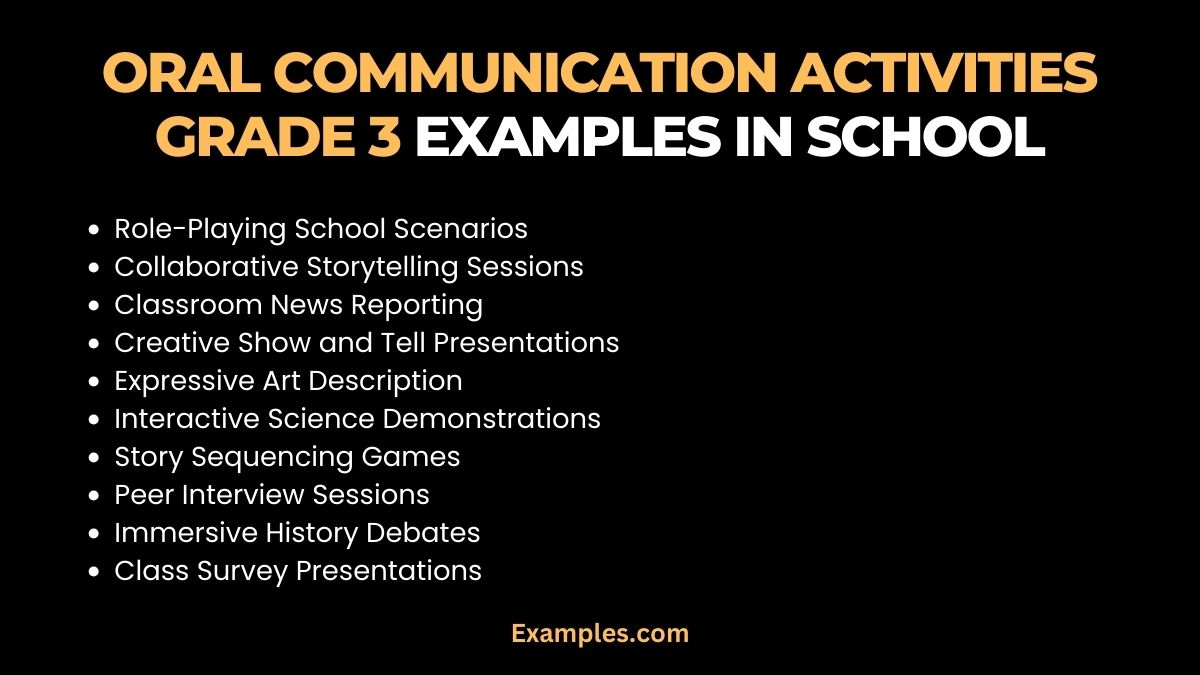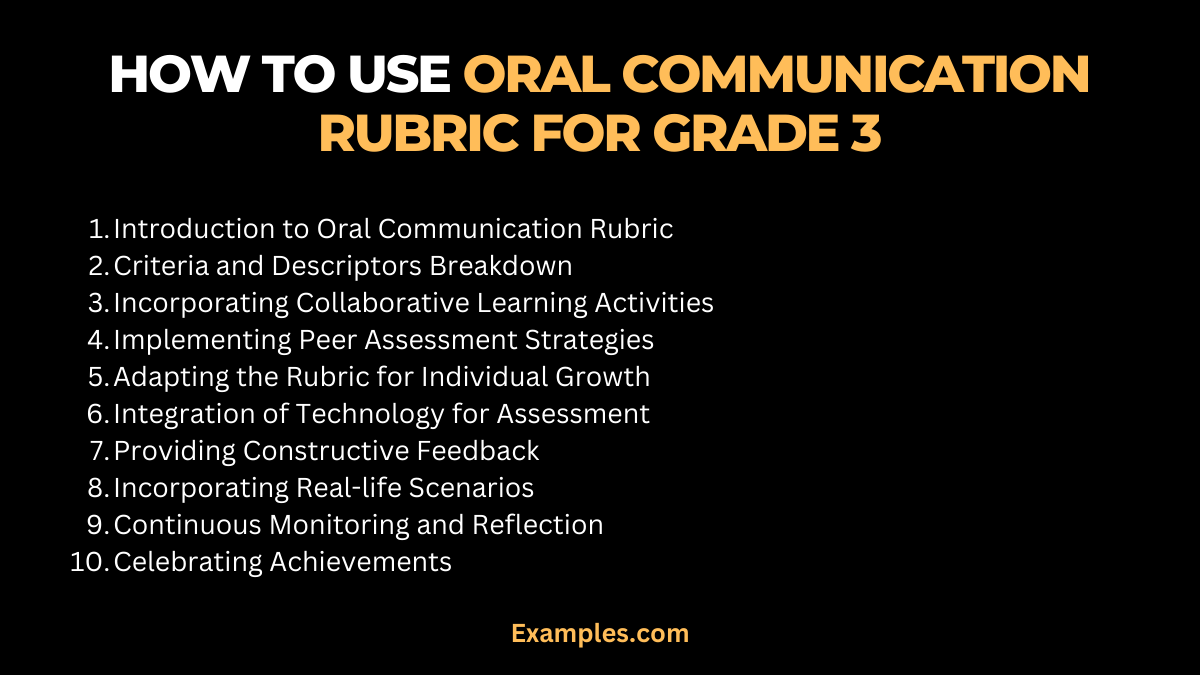29+ Oral Communication for Grade 3 Examples
Welcome to the complete guide on Oral Communication for Grade 3, where we delve into essential skills through vivid Communication Examples. Nurturing effective communication skills in young minds is crucial, and this article equips you with the knowledge and examples needed. Explore a comprehensive overview, practical tips, and engaging activities to enhance your child’s communication abilities. From oral presentation topics to interpersonal skills, this guide covers it all, making learning a joyful experience. Let’s embark on this educational journey together.
What is Oral Communication for Grade 3?
Oral communication for Grade 3 refers to the interactive process of conveying messages through spoken words. In simple terms, it involves verbal exchanges and expression of ideas among third-grade students. This crucial skill encompasses various activities, including oral presentations and interpersonal communication. Developing effective oral communication at this stage lays the foundation for a lifetime of successful interaction. Let’s explore the significance and nuances of oral communication for Grade 3 in this comprehensive guide.
What is the best Example of Oral Communication for Grade 3?
Imagine a classroom scenario where a third-grade student confidently presents a short story to the class. This exemplary oral communication moment involves clear articulation, expressive language, and engaging storytelling. The student not only conveys the narrative effectively but also captures the attention of peers through expressive gestures and appropriate tone. This example showcases the development of essential communication skills at Grade 3, emphasizing the importance of effective expression and engagement. Let’s delve deeper into this illustrative example and unravel the elements that make it stand out.
30 Oral Communication for Grade 3 Examples
1. Boldly Introducing Oneself: In this example, students master the art of confidently introducing themselves to peers and adults, fostering self-expression.
2. Sharing Personal Experiences: Encourage storytelling as students share personal experiences, enhancing their narrative and descriptive communication abilities.
3. Expressing Feelings Through Art: Explore the emotional realm as students use art to express feelings, promoting a creative approach to communication.
4. Active Listening Games: Through interactive games, students learn the significance of active listening, a fundamental aspect of effective communication.
5. Group Problem-Solving Discussions: Engage Grade 3 students in collaborative discussions, fostering teamwork and enhancing their ability to communicate ideas collectively.
6. Show and Tell Sessions: Encourage students to articulate their thoughts while presenting objects, honing their descriptive and presentation skills.
7. Role-Playing Scenarios: Dive into imaginative worlds with role-playing exercises, where students practice communication through diverse characters and situations.
8. Conducting Mini Debates: Foster critical thinking and articulate expression by organizing mini debates on fun and thought-provoking topics.
9. Giving Clear Instructions: Develop clarity in communication as students practice giving step-by-step instructions, refining their communication precision.
10. Asking Thoughtful Questions: Instill curiosity and effective inquiry by teaching students how to ask meaningful questions that promote insightful discussions.
11. Classroom News Reporter: Transform students into news reporters, enhancing their storytelling skills while delivering classroom news updates.
12. Peer Compliment Circles: Cultivate positivity by encouraging students to give and receive compliments, fostering a supportive communication environment.
13. Expressing Gratitude: Teach the art of expressing gratitude, promoting positive communication habits that extend beyond the classroom.
14. Telephone Game Variations: Explore different versions of the classic telephone game, showcasing the impact of communication breakdowns and the importance of clarity.
15. Story Sequencing Exercises: Develop sequencing skills through storytelling, enhancing students’ ability to organize thoughts and communicate coherently.
16. Vocabulary Building Games: Incorporate fun games to expand vocabulary, empowering students with a diverse range of words for effective communication.
17. Imaginary Adventure Narratives: Fuel creativity by guiding students to narrate imaginary adventures, fostering descriptive and engaging storytelling.
18. Reflective Journal Entries: Introduce reflective journaling as a tool for self-expression, allowing students to communicate personal thoughts in a written format.
19. Emotion Charades: Enhance emotional intelligence as students express various emotions through charades, promoting nonverbal communication skills.
20. Group Story Creation: Collaboratively create stories as a class, emphasizing the importance of effective communication in group settings.
21. Weather Forecast Presentations: Merge science and communication by having students present imaginative weather forecasts, showcasing informative and engaging communication.
22. Classroom Survey Discussions: Teach survey-taking and result discussions, encouraging students to articulate findings and opinions.
23. Historical Figure Interviews: Immerse students in history by conducting interviews as famous historical figures, combining research with expressive communication.
24. Science Experiment Narratives: Communicate scientific findings through experiment narratives, emphasizing clear and concise reporting.
25. Art Appreciation Discussions: Promote expressive communication by discussing various art forms, encouraging students to share interpretations and opinions.
26. Collaborative Story Building: Foster teamwork as students collectively build stories, showcasing the power of collaborative communication.
27. Socratic Circle Discussions: Elevate critical thinking through Socratic circles, where students engage in thoughtful and articulate discussions.
28. Comedic Storytelling: Explore the lighter side of communication by encouraging humorous storytelling, enhancing creativity and expressive skills.
29. Cultural Exchange Dialogues: Broaden horizons through cultural exchange dialogues, promoting understanding and respectful communication.
30. Mindful Listening Exercises: Conclude with mindfulness, introducing exercises that enhance focus and attentive listening in communication scenarios.
Oral Communication Activities Grade 3 Examples in School

Explore dynamic oral communication activities tailored for Grade 3 within a school setting. Elevate classroom interactions with engaging exercises that enhance communication skills. Dive into this curated collection, designed to make learning an exciting and expressive journey for young students.
- Role-Playing School Scenarios: Engage students in imaginative play, promoting communication skills through scenarios like teacher-student interactions and more.
- Collaborative Storytelling Sessions: Encourage teamwork by having students collectively weave creative stories, fostering expressive communication.
- Classroom News Reporting: Transform students into news reporters, refining their articulation skills while delivering captivating classroom updates.
- Creative Show and Tell Presentations: Amplify self-expression as students present unique objects, refining their descriptive communication abilities.
- Expressive Art Description: Infuse creativity into communication with activities where students articulate their feelings and thoughts about different art pieces.
- Interactive Science Demonstrations: Merge science education with communication by having students present engaging demonstrations, ensuring clarity in explanation.
- Story Sequencing Games: Develop organizational skills through storytelling games, enhancing students’ ability to communicate coherently.
- Peer Interview Sessions: Foster communication and empathy through peer interviews, where students engage in thoughtful conversations.
- Immersive History Debates: Explore historical topics through debates, encouraging students to articulate opinions with historical context.
- Class Survey Presentations: Teach survey-taking skills and result discussions, empowering students to communicate findings effectively.
Oral Communication for Grade 3 Examples in Class
Immerse Grade 3 students in a variety of classroom-specific oral communication examples. From interactive lessons to collaborative discussions, these activities aim to make the classroom a vibrant space for developing effective communication skills.
- Question and Answer Sessions: Encourage active participation by hosting Q&A sessions, where students articulate questions and answers confidently.
- Math Problem Solving Dialogues: Merge mathematics with communication, allowing students to discuss problem-solving approaches and solutions.
- Literature Circle Discussions: Enhance reading comprehension and communication through literature circle discussions, fostering critical thinking.
- Interactive Geography Presentations: Explore the world through geography presentations, where students communicate facts and insights about different countries.
- Classroom Debate Club: Establish a debate club within the class, promoting articulate expression of opinions on various topics.
- Role-Playing Historical Events: Bring history to life with role-playing activities, allowing students to communicate their understanding of historical events.
- Expressive Music Appreciation: Blend the arts with communication by discussing musical pieces, encouraging students to express their feelings and interpretations.
- Collaborative Science Projects: Foster teamwork and communication with group science projects, where students collectively present their findings.
- In-Class Poetry Readings: Cultivate a love for language through poetry readings, allowing students to express emotions and thoughts creatively.
- Interactive Language Learning Games: Make language learning engaging with interactive games, where students communicate in the target language for effective learning.
How to use Oral Communication Rubric for Grade 3?

In this comprehensive guide, we will delve into the effective utilization of an oral communication rubric tailored for Grade 3 students. By employing this tool, educators can assess and enhance the communication skills of young learners. Let’s explore the practical steps on how to make the most out of the oral communication rubric.
1. Introduction to the Oral Communication Rubric
Begin by introducing the oral communication rubric to Grade 3 students. Explain its purpose in evaluating their communication skills, emphasizing its role as a guide for improvement.
2. Breakdown of Criteria and Descriptors
Break down the rubric into specific criteria and descriptors. Ensure that each criterion is clearly defined, providing students with a detailed understanding of what is expected in their oral communication.
3. Collaborative Learning Activities
Incorporate collaborative learning activities into the rubric. Encourage students to engage in group discussions, presentations, and activities that promote teamwork, as these contribute to their overall communication development.
4. Peer Assessment Strategies
Implement peer assessment strategies using the rubric. Guide students on evaluating their peers’ communication skills, fostering a sense of responsibility and encouraging constructive feedback.
5. Tailoring the Rubric for Individual Growth
Highlight the adaptability of the rubric for individual growth. Showcase how students can set personal communication goals and track their progress using the rubric as a self-assessment tool.
6. Integrating Technology for Assessment
Explore the integration of technology for assessment purposes. Discuss how video recordings or digital presentations can be utilized to assess and improve oral communication skills, aligning with modern educational practices.
7. Providing Constructive Feedback
Emphasize the importance of constructive feedback. Guide educators on how to provide specific, actionable feedback using the rubric, focusing on areas of improvement while acknowledging strengths.
8. Incorporating Real-life Scenarios
Demonstrate the applicability of the rubric to real-life scenarios. Develop activities that simulate situations where effective communication is crucial, allowing students to apply their skills in practical contexts.
9. Continuous Monitoring and Reflection
Highlight the need for continuous monitoring and reflection. Encourage students to regularly assess their communication skills, fostering a habit of self-reflection and a commitment to ongoing improvement.
10. Celebrating Achievements
Finally, celebrate achievements and improvements. Establish a positive environment where students feel encouraged and motivated to enhance their oral communication skills, creating a foundation for lifelong communication success.
As we conclude this exploration of Oral Communication for Grade 3, it’s evident that nurturing communication skills at an early age lays the foundation for a lifetime of effective expression. The journey through this guide has highlighted the significance of fostering clear articulation, active listening, and the ability to express thoughts coherently. These skills not only contribute to academic success but also play a crucial role in personal development.
To further enhance your understanding of oral language development and its importance in the educational journey of third graders, consider exploring the resources provided by the Digital Children’s Reading Initiative. This initiative, managed by the North Carolina Department of Public Instruction, offers valuable insights and tools to support parents and educators in fostering strong oral language skills in third-grade students.
Additionally, for a deeper dive into communication and language development in a school-age context, the Virtual Lab School provides a comprehensive lesson. Developed to enhance the skills of educators and caregivers, this resource offers practical guidance on promoting effective communication in school-age children. Delve into these authoritative sources to continue your journey toward enriching oral communication skills in Grade 3 students.



